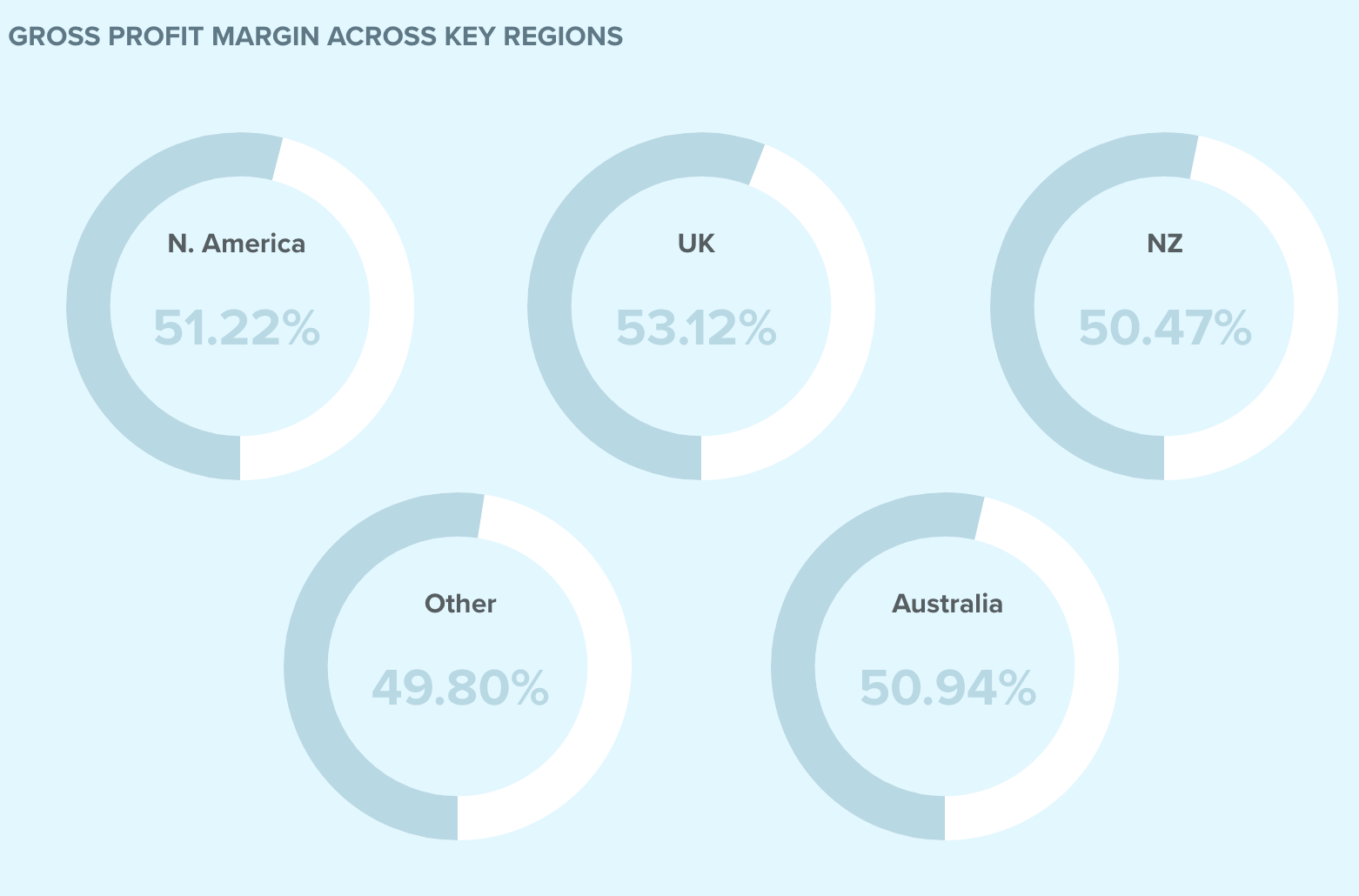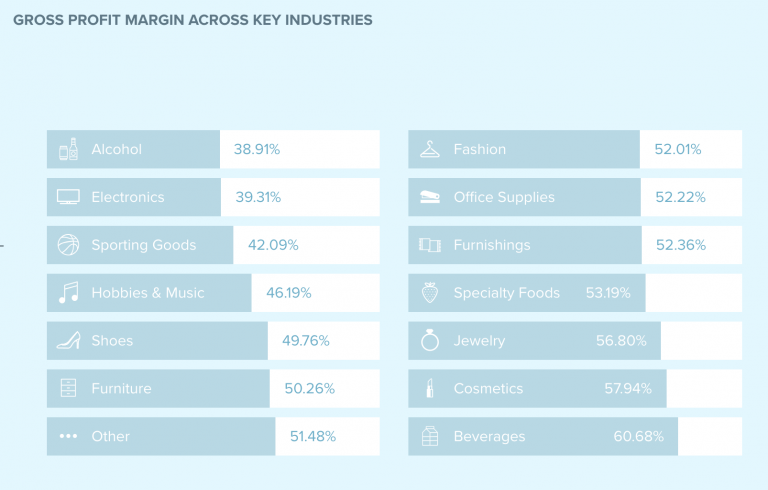It’s important to note, though, that your profit margin isn’t just something you should measure; it’s a metric that you should continuously improve. As author Doug Hall said, “If your profit margins aren’t rising, chances are your company isn’t thriving.”
What is the average profit margin in retail?
In our study of 13,000+ retailers, we found that the average gross profit margin in retail is 50.96%. Comparing the data across regions, we didn’t find a lot of variances in profit margins, though the UK leads slightly at 53.12%.
 That said, differences in margins were much more pronounced when we compared the data across multiple industries. Beverage manufacturers, cosmetics, and jewelry stores had some of the highest profit margins, with 60.68%, 57.94%, and 56.80%, respectively. Meanwhile, alcoholic beverages, electronics, and sporting goods stores had some of the lowest margins at 38.91%, 39.31%, and 42.09% respectively.
That said, differences in margins were much more pronounced when we compared the data across multiple industries. Beverage manufacturers, cosmetics, and jewelry stores had some of the highest profit margins, with 60.68%, 57.94%, and 56.80%, respectively. Meanwhile, alcoholic beverages, electronics, and sporting goods stores had some of the lowest margins at 38.91%, 39.31%, and 42.09% respectively.
How to Increase Your Profit Margins
Now that you have a better idea of the amount of profit that retailers are taking in, it’s time to look at the specific ways that you can increase your profit margins.
Here are 8 things you can try:
1. Avoid markdowns by improving inventory visibility
Markdowns are notorious profit-killers, so avoid them whenever possible. How do you do that? Start by improving how you manage your inventory. You should always have a handle on the merchandise you have on hand, as well as what your fast and slow-movers are. This will help you make better decisions around purchasing, sales, and marketing, allowing you to sell more products and reduce the need for markdowns.
“One way to maximize margins which also has other significant benefits is to have 100% visibility of inventory. By doing so, this minimizes markdowns and thus margin erosion. Zara are a particularly good example of this,” says Andrew Busby, Founder & CEO at Retail Reflections.
He adds, “Another way to maximize margins is to have an effective Product Information Management (PIM) system. With multiple channels and especially given the rapid rise of fast fashion — for example, ASOS adds around 5,000 new products each week to its website — giving the entire enterprise full, consistent visibility of product inventory means being agile and able to respond rapidly to shifting trends and constant changes in demand.”
Key takeaways:
- Improve your inventory management practices. Get a handle on your data and always know what you have on hand, what’s selling, and what’s not moving.
- Use those inventory insights to make decisions around purchasing, sales, and marketing.
2. Elevate your brand and increase the perceived value of your merchandise
It’s interesting to see that cosmetics retailers have some of the best margins in retail. According to experts, one reason behind this is the fact beauty and cosmetics brands excel at creating personal and emotional connections with customers.
Beauty is a category on fire…The price value equation is quite good, cosmetics make people feel better about themselves and foster strong customer loyalty, and the merchandising creates a sense of exploration…”
– Laura Heller, Editor, Retail Dive
She continues, “We ran a story earlier this year titled “Why beauty will continue to rule retail in 2018” that outlines some of the reasons behind this trend. The product category creates a kind of personal connection with shoppers, unlike many other consumer goods. The price value equation is quite good, cosmetics make people feel better about themselves and foster strong customer loyalty, and the merchandising creates a sense of exploration — something the off-price retailers have also done quite well. Depending on the brand, packaging, and marketing attached, the profit on each small item can be really high.”
Chris Guillot, Instructional Designer of Merchant Math and Founder of Merchant Method, offers a similar view, saying that “cosmetics brands do a great job with brand management, playing to their customer base at an emotional level — status and lifestyle.”
According to Guillot, “Retailers of all sizes and stages of growth can focus on their unique brand positioning as a way to differentiate from their competitors and increase perceived value.”
Key takeaways:
- Find ways to increase the perceived value of your brand. You can do this by focusing on the emotional and lifestyle values that your merchandise can offer.
- For example, can your products make people feel better about themselves? Can they elevate the lifestyle of your customers? Brands that are able to these things can often charge a premium for their products.
3. Streamline your operations and reduce operating expenses
“Retailers often focus on pricing strategies when searching for ways to increase profits, but most should try to start with streamlining operations,” says Krista Fabregas, a retail analyst at FitSmallBusiness.com
“First, cut overtime and excess staffing as much as possible, then focus on areas of waste. Minimize supply: spend as little as possible, and ditch the fancy printed shopping bags, tissue fill, and excess packaging wherever possible. If you’re not using an efficient point-of-sale to tie inventory, sales, and marketing under one system, consider making a switch to a low-cost system. This makes your entire store and staff run more efficiently.”
Another great way to streamline your operations is to automate specific tasks in your business. By putting repetitive activities on autopilot, you can reduce the time, manpower, and operating expenses required to run your business.
Go through all the tasks that you and your employees complete day-to-day, and see if you can automate any of them. Are there cumbersome activities that are eating chunks of your time? Do you have to re-enter any data or perform certain steps more than once? Look for solutions that can take care of them for you.
Take, for instance, Crane Brothers, a contemporary menswear retailer. To save time and operating expenses, Murray Crane decided to automate the task of transferring sales data to his accounting software. Rather than manually plugging the numbers into the program, he integrated his point-of-sale system (Vend) with his accounting software (Xero). He got the two tools talking to each other so that information is automatically transferred from one program to the next.
The result? Murray was able to free up time so he and his staff could devote more energy to helping customers. He also estimates that the automated system in his store saves him forty to eighty hours a week — or one to two full-time employees.

Data entry isn’t the only thing you can automate. These days, there’s (usually) an app for most of the tedious administrative tasks in your store.
If you regularly make appointments with customers, for example, consider using an app such as Timely, which streamlines bookings and sales, and even sends automatic appointment reminders to your customers. Do you spend a lot of time managing employee shifts? Check out Deputy, which lets you and your staff coordinate schedules from your mobile devices and sends shift changes and notifications for you.
Key takeaways:
- Lower your overhead by reducing wasteful spending and by using less expensive supplies (as long as you don’t compromise quality).
- Automate repetitive tasks to save time and further reduce your expenses.
- If you’re using Vend, visit our add-ons page and find tools that can help you automate tasks in your business.
4. Increase your average order value
Increasing the basket size or average order value (AOV) from shoppers already in your store is a great way to improve your profits. You’ve already invested in getting them to your location; now go and find ways to maximize their spend.
Start with upselling and cross-selling. As Matthew de Noronha, Head of SEO at Eastside Co., puts it, “someone who makes a purchase from you has already been qualified. They have engaged with your brand and, while it may sound obvious, they are significantly more receptive to offers and product advertising. For that reason, it makes complete sense to encourage them to spend more.”
Matthew says that you can start by finding products likely to be purchased together. Then, after a user has committed to purchasing a product, encourage increased spending by recommending relevant items.
Strategic product placement in-store can also increase AOV. Adam Watson, director of Decorelo, recommends putting “your most profitable products in the shop window and in the best area customers naturally go to in the store so as many eyeballs see them as possible.” Doing so will help you sell your most profitable items, contributing more to your bottom line.
Another tactic is to “put your best sellers and upsells near the counter for impulse buys to increase average order value,” says Adam.
Key takeaways:
- Increase basket size through suggestive selling.
- Find your most profitable products and position them high-traffic areas of your store.
- Promote impulse buys at the checkout counter.
5. Implement savvier purchasing practices
Whether you’re at a trade show looking at new products or at the negotiating table with your suppliers, make sure you’re always finding ways to lower costs.
Think about the final cost
One of the best ways to do this, according to business coach Lindsay Anvik, is to “approach products by factoring in the final cost (i.e., wholesale cost, taxes, shipping, etc.). Once you have that final figure, ask yourself, ‘Would I pay X for this?’. If you wouldn’t, you need to find a way to lower the cost or move on from the product.”
Ask for vendor discounts or offers
Lindsay also recommends asking for discounts (e.g., free shipping) or other offers (e.g., throwing in a couple of extra products for free). This works particularly well when you’re buying in bulk.
Lindsay, for example, once helped her client “negotiate $2 off of every garment they ordered. The client was a top customer, paid on time and was easy to work with. The vendor was happy to give this discount because it didn’t hurt his bottom line too much. And because my client was a good customer, he was willing to negotiate to keep her happy.”
Increase order quantities
Let’s say you need to up your order quantities for a particular item to lower its price. In this case, you could look at your inventory data and determine if you can afford to order certain items in bulk. If not, would it be possible for you to consolidate orders for other items (or with other purchasers) to increase your buying power?
This is something that many large retailers have been doing for quite some time now. A few years ago, for example, Walmart sought out joint purchasers for raw materials, so they can consolidate purchases and get more buying clout.
Explore your options and run them by your suppliers to see if you can negotiate better deals. If they don’t budge, then check out other vendors to find out if they can offer you more favorable terms. (And make sure your existing suppliers are aware of this — they could end up giving you better rates.)
Key takeaways:
- Before finalizing an order, always consider the final cost by factoring in taxes, shipping expenses, and more.
- Don’t be afraid to ask your vendor to give you a discount or throw in a few extra units.
- “Buy with other stores,” says Lindsay. “Get together with another store owner (or owners) and buy together. This way you can ask for a bigger discount from wholesalers.
6. Increase your prices
Raising your prices will enable you to make more money on each sale, thus widening your margins and improving your bottom line. Many retailers, however, balk at the prospect of increasing their prices out of fear that they’ll lose customers.
We wish we could give you hard and fast rules when it comes to pricing, but the fact is, this decision depends on each company’s products, margins, and customers. The best thing to do is to look into your own business, run the numbers, and figure out your pricing sweet spot.
On top of considering basic pricing components like your costs and margins, look at external factors such as competitor pricing, the state of the economy, and the price sensitivity of your customers.
And consider what types of customers you want to attract. Do you want to sell to shoppers would take their business elsewhere just because they could get an item for less, or would you rather attract customers who don’t base their purchase decisions solely on price?
You’d be surprised to find that majority of consumers (though this may vary from one industry to the next) may actually belong to the latter group. A study by Defaqto has found that “55% of consumers would pay more for a better customer experience.
Take all these things into consideration; do the math, and once you come up with a price increase, test it on a few select products then gauge customer reaction and sales from there. If the results are positive, roll out the increase across all your products.
Be creative with your price increases
You may also want to consider implementing creative or psychological tactics when coming up with your prices, to make them more appealing. You can, for instance, incorporate tiered pricing into your strategy.
Check out what shoe retailer Footzyfolds did. To combat cheaper knock-offs of its merchandise (they were selling them for $25, while Target had them for $10) the store decided to revamp its prices — but not in the way you might think.
Instead of lowering prices across the board, Footzyfolds introduced a high-end category for their products. With the new pricing format, they lowered the price of their everyday products to $20 a pair, but introduced a new “Lux” category for $30 a pair.
Owner Sarah Caplan told the New York Times that this move helped them increase profits. “We actually have had the most interest in our higher-priced shoes,” she said to the publication and reported that after launching the high-end line in the summer of 2010, they saw revenues increase by 100%.
Key takeaways:
- If it makes sense for your business, go ahead and raise your prices. Krista recommends that you start with your top sellers. “Do you have a lot of competition, or do your products stand alone? If so, raise your prices on these products.”
- Be creative with your prices. Factor in psychology or use methods like tiered pricing.
- To learn more about tiered pricing and other strategies, check out our post on the secrets to irresistible pricing.
7. Optimize vendor relationships
Earlier in this post, we talked about negotiating better contracts with your suppliers to reduce the costs of goods and widen your margins. If you want to take things a step further, consider building stronger relationships by working more closely with them.
Engage in Joint Business Planning
Daniel Duty, co-founder and CEO of Conlego, says that retailers should engage in Joint Business Planning with vendors. “This is a collaborative tool whereby profit goals are agreed to, and initiatives are developed to help reach those goals. In other words, both sides help each other become more profitable,” he shares.
Reduce supply chain costs and inefficiencies
“The supply chain — or the process of getting a product from the factory to the store floor — is always full of inefficiencies and huge costs,” adds Daniel.
“Retailers should study their supply chain to figure out where there are unnecessary costs. For instance, shipping product in less than a full truckload is more costly than when it is full. Making many deliveries each week to a store is more expensive than just one. Retailers should ask their suppliers if they are doing anything that is adding to costs to the supply chain that could be stopped.”
It helps to have a discussion with your vendors to see if there’s anything you can do to make things easier or more cost-effective.
That’s what photo digitization service ScanMyPhotos.com did. President and CEO Mitch Goldstone says that collaborating closely with their vendors enabled them to enhance their business processes. “We invite our vendors to think of us as a partner. The better we do, the better they do. The process is simple, just ask vendors to help improve your workflow.”
Mitch shares that they even invited one of their vendors, the United States Postal Service, to visit their headquarters. “We asked them to study our entire shipping operation and the technology that drives our fulfillment services. Many, many elements we thought helped streamline the business, were all wrong and the USPS marketing team became our best partner to reinvent everything.”
See if you can do the same thing in your business. Strengthen your relationships with vendors and determine how you can work better together. Doing so could help you identify ways to reduce product costs and operating expenses. Or, at the very least, it could improve your workflow and productivity.
Key takeaways:
- Have a collaborative relationship with your vendors. Engage in Joint Business Planning and figure out how you can both improve profitability.
- Identify inefficiencies in your supply chain and find ways to reduce them.
8. If you *must* discount your products, be smart about it.
While discounting typically goes against traditional advice on profitability, it could work to your advantage if you do it right.
Consider personalized offers
For instance, you could try to provide tailored offers. Remember that not all customers are wired the same way. Some people may need a 20% off incentive to convert, while others don’t really require a lot of convincing.
Instead of killing your profits with large, one-size-fits-all offers, identify how big of a discount is necessary to convert each customer.
Case in point: Online bicycle retailer BikeBerry.com. The e-tailer sought the help of big data company Retention Science to analyze customer behavior and gather intel on their customers’ past purchases, browsing history, and more. This allowed them to get to know their customers and figure out the most cost-effective way to convert each one.
They then created a series of email campaigns with five different discount offers tailored to each individual. Customers received one of the following offers in their inbox: Free Shipping (which is huge because shipping costs can run high for bikes and other accessories), 5% off, 10% off, 15% off, and $30 off new products.
The campaigns ran for two months and within that period, BikeBerry not only increased sales, but they were able to widen their profit margins by not offering discounts that are too big to customers who would convert at a lower threshold.
See if you can do something similar in your business. Instead of offering blanket discounts, go through the purchase histories of your customers, then personalize your offers based on their behavior and preferences. Doing so won’t just increase the chances of conversion (people are more likely to respond to an offer if it’s relevant to them), it’ll also help you maximize your margins.
Time them right
Timing is also critical. As M. Pope Anthony, president and buyer at Anthony’s Ladies Apparel, notes, “there is a fine line between too soon and too late. If you hold on to items too long, you will eventually have to sell them at a much deeper discount.
Good historical information and experience are crucial. Being overstocked on old, undesirable inventory will tie up your dollars and prevent you from buying new products. Eventually, your volume will decline, rendering you with fewer margin dollars.
Be sensible about your discounts
“Profit margins can be improved through sensible couponing,” says Matthew. “I’ve worked with many retailers who see the increased number of orders from promotions and sales.
But Matthew stresses the importance of analyzing your promotions to ensure that they’re not harming your margins.
According to him, you need to ask key questions such as, “How many more orders has a promotion brought in (compared to the average number of sales)? How much revenue did your promotion bring in, and how does this compare to average after your overheads and the discount has been taken into account?”
He adds, “One effective way to find this out is through A/B testing, offer your promotion to half your users (either through emails, targeted ads, onsite, etc.). This test may need to be run a few times to become significant. But very quickly you’ll be able to compare the profit made between the two groups — identifying whether your promotions are actually cannibalizing your returns.”
Key takeaways
- Personalize offers so you’re not giving away too big of a discount to people who would convert at a lower threshold
- Test different types of promotions to see which ones are really making you money
Bottom line
You don’t always have to make drastic changes in your business to significantly improve your bottom line. As this post has shown, sometimes a simple tweak in your pricing or a phone call to your vendor can pave the way for wider margins.


